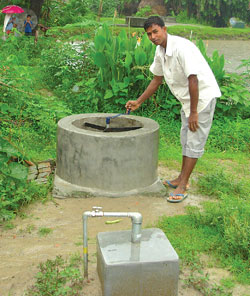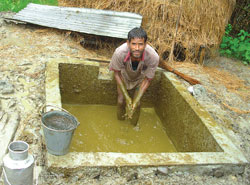|
|
| DUNG POWER: In villages like Dumartoka, Ilam cowdung is not only sacred but is also becoming increasingly valuable as more people use biogas as their primary resource. |
The unbeatable combination of cow dung and sunshine has made Jit Narayan Chaudhary a happy farmer. In the four months since he installed his biogas plant, he has seen his household running costs fall dramatically. He is saving Rs 60 each day that he used to spend on firewood for his family's cooking needs. The residual slurry from his biogas digester is far superior to the urea and potassium fertiliser he used to buy for nearly Rs 10,000 each year.
Jagita, his wife, is smiling too. She no longer has to spend hours fetching firewood, then more hours struggling with the cooking over a smoking, temperamental fire.
She longer faces the bother of having to clean the grey wood ash and smoke residue from the inside of her neat and tidy home.
Such stories about biogas are already old hat in Nepal, but the consistent success of this simple technology, and its popularity among users, continues to inspire more people to build their own biogas plants from the sweltering tarai to 3,000m up in Solukhumbu.
One of the leaders in this energy revolution has been Biogas Sector Partnership-Nepal (BSP), which works with the government's Alternative Energy Promotion Centre (AEPC) to promote biogas.
BSP says there are now more than 170,000 households using this technology in Nepal, making the country a world model for successful biogas programs. (See: 'Nepal's future is in the dung heap', # 167)
Each family switching to biogas saves 15 to 20kg of firewood every day, AEPC estimates. While this is great news for the trees, it is also starting to earn Nepal big money through carbon emissions trading.
"The key aim of biogas has always been to prevent the exploitation of forests, and this is the reason that agencies working in this sector need to help the poor to build their own plants," says Dilip Kumar Bhandary, a 30-year veteran of biogas technology in Ilam district.
BSP now plans to work with other communities to help poor farmers buy livestock, from which an important by-product is the dung needed for the biogas plant.
Carbon cash
 In Kathmandu and other urban centres we pollute the environment and emit ever-increasing amounts of carbon dioxide while our rural neighbours like Narayan Chaudhary (pictured) are switching to biogas are doing just the opposite.
In Kathmandu and other urban centres we pollute the environment and emit ever-increasing amounts of carbon dioxide while our rural neighbours like Narayan Chaudhary (pictured) are switching to biogas are doing just the opposite.
A family converting from firewood or kerosene to biogas reduces its carbon emissions by an estimated 7.4 tonnes of carbon dioxide each year, helping Nepal increase its carbon-trading credits. So far, more than 170,000 households have made the switch.
Since January, Nepal has been selling spare carbon credits through the World Bank for $7 per tonne of carbon dioxide, and now the government's Alternative Energy Promotion Centre (AEPC) has negotiated a price rise to $10.25 per tonne.
The AEPC has been working with Biogas Sector Partnership-Nepal, WWF Nepal and the Gold Standard, a Swiss-based non-profit foundation, to develop income generation through carbon trading. The government estimates that Nepal will have traded about 96,000 tonnes of carbon dioxide by 2012.
Nepal is already earning over $600,000 per year through its Voluntary Emissions Reductions, which unlike the Compulsory Emissions Reductions of the Kyoto Protocol are not bound by any UN convention. Direct trading deals can be made between the country and a private company, which wants to buy the carbon credits to offset its own emissions. If this year's Kyoto Protocol conference in Bali accepts that countries protecting forests would be eligible for carbon credits, Nepal will benefit further.
But it remains uncertain if this idea will win approval, given that industrialised countries without forest reserves oppose the idea of rewarding forest-rich countries like Brazil, Indonesia, Argentina or even Nepal, where biomass is renewable and thus not contributing to the reduction of carbon emissions.
"Whether biomass is renewable or not depends on each country and in our case, our depleted forests are not able to be restored," says WWF Nepal's Sandeep Chamling Rai. Until now, China, Brazil and India have been the biggest sellers of carbon credits, with nearly 62 percent of the trade going to China, 12 percent to Brazil and four percent to India.
Still too costly
 The almost-free energy from biogas technology is wonderful if you've got cows, but for the poorest households the initial capital investment is still far beyond their means.
The almost-free energy from biogas technology is wonderful if you've got cows, but for the poorest households the initial capital investment is still far beyond their means.
"Even if they try hard to get loans to pay for at least half of the construction cost, they still can't afford it all," says Tilak Shrestha, manager of Kantipur Gobar Gas in Mahottari, where his company has built over 500 plants in the last three years.
But it is possible to make the technology accessible to the poorest groups, who of course are the ones most likely to be using forest resources such as firewood.
The cost of a complete biogas plant and cooker is more than Rs 30,000, but the farmers can receive a government subsidy for half that, funded through German and Dutch aid. For the balance of Rs 15,000, most farmers turn to Grameen Bank for low-interest 50-week loans. But they still need to provide sufficient property as collateral, which is beyond the means of some. The World Bank-supported Poverty Alleviation Fund can help with barely Rs 1,000, but there are other options.
Some biogas users have formed their own credit groups and help their poorer neighbours like Chandralal Chaudhary (pictured) by providing loan guarantees that are acceptable to the Agricultural Development Bank or Grameen.
Community forest user groups are also getting involved. The Parsahi Arne Bhulke group in the village of Parsahi in Mahottari district has built plants for nearly 60 families. Saroj Raj, managing director of Biogas Sector Partnership-Nepal, would like to see commercial banks showing more interest in helping poor households adopt biogas technology, because in the long term the benefits will be not just for the users but the nation as a whole, especially in helping conserve Nepal's forests.
High on methane
Households in the mountain districts of Solukhumbu and Rasuwa are already using biogas up to an altitude of 3,000m, but supporters of this renewable energy source would like to go higher.
"We want to go all over the country, even to the high mountains," said Saroj Rai, managing director of Biogas Sector Partnership-Nepal (BSP), an NGO that is implementing the fourth phase of a 15-year-old biogas support program.
Rai acknowledges this will take time, and there are technical problems to overcome, mainly because methane bacteria can't survive in colder regions. BSP-Nepal is trying to overcome this by placing compost heaps on top of the digester to provide insulation. But even this is not enough and a pilot project is trying to graft solar water heaters to biogas plants to keep the digesters at about 25 degrees Celsius.



